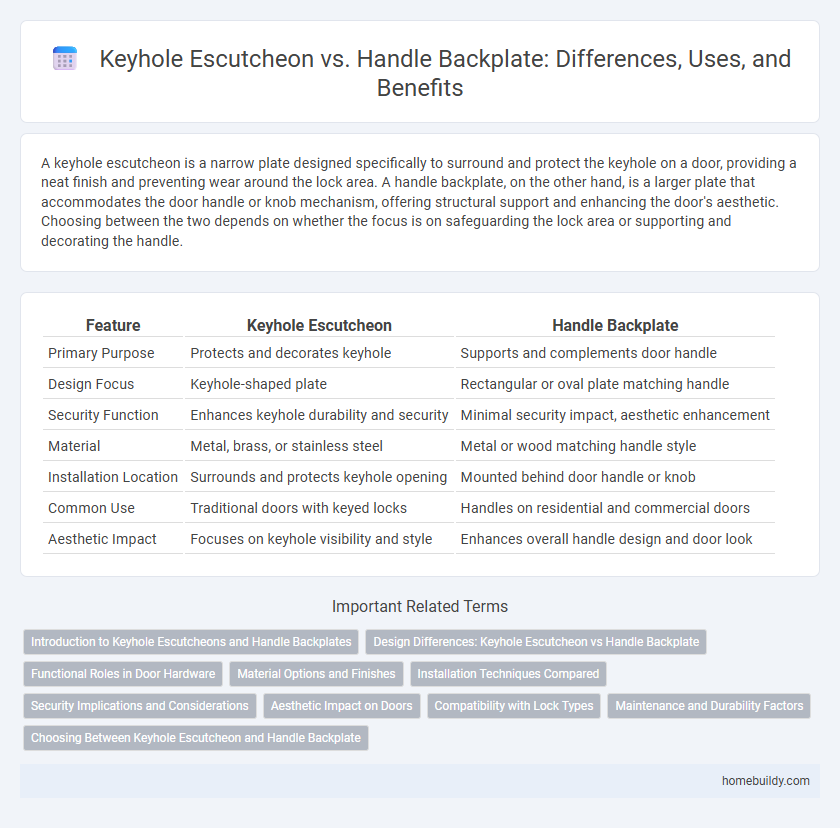A keyhole escutcheon is a narrow plate designed specifically to surround and protect the keyhole on a door, providing a neat finish and preventing wear around the lock area. A handle backplate, on the other hand, is a larger plate that accommodates the door handle or knob mechanism, offering structural support and enhancing the door's aesthetic. Choosing between the two depends on whether the focus is on safeguarding the lock area or supporting and decorating the handle.
Table of Comparison
| Feature | Keyhole Escutcheon | Handle Backplate |
|---|---|---|
| Primary Purpose | Protects and decorates keyhole | Supports and complements door handle |
| Design Focus | Keyhole-shaped plate | Rectangular or oval plate matching handle |
| Security Function | Enhances keyhole durability and security | Minimal security impact, aesthetic enhancement |
| Material | Metal, brass, or stainless steel | Metal or wood matching handle style |
| Installation Location | Surrounds and protects keyhole opening | Mounted behind door handle or knob |
| Common Use | Traditional doors with keyed locks | Handles on residential and commercial doors |
| Aesthetic Impact | Focuses on keyhole visibility and style | Enhances overall handle design and door look |
Introduction to Keyhole Escutcheons and Handle Backplates
Keyhole escutcheons are protective or decorative plates surrounding keyholes, designed to enhance the appearance and security of doors while preventing wear around the lock area. Handle backplates, on the other hand, serve as mounting plates for door handles, offering structural support and aesthetic appeal by covering the area behind the handle. Both components contribute to door hardware functionality, but keyhole escutcheons specifically address keyhole protection, whereas handle backplates primarily focus on handle installation and reinforcement.
Design Differences: Keyhole Escutcheon vs Handle Backplate
Keyhole escutcheons feature a compact design focused on protecting and highlighting the keyhole area, often with decorative shapes that complement the lock mechanism. Handle backplates are generally larger, extending behind the door handle to provide additional mounting support and aesthetic balance, often incorporating both functional and ornamental elements. The design difference centers on size and purpose: keyhole escutcheons emphasize keyhole protection, while handle backplates serve as a structural base for door handles and enhance visual coherence.
Functional Roles in Door Hardware
Keyhole escutcheons provide a protective and decorative cover specifically around keyholes, enhancing security by preventing tampering and wear. Handle backplates serve as a foundational mounting surface for door handles, distributing mechanical stress and protecting the door surface from damage caused by repeated use. Both components contribute to door hardware functionality but focus on distinct roles: keyhole escutcheons center on lock access protection, while handle backplates emphasize handle stability and door integrity.
Material Options and Finishes
Keyhole escutcheons typically come in solid brass, stainless steel, or zinc alloy, offering durability and corrosion resistance ideal for various door types. Handle backplates are often available in similar materials but may also include aluminum for lightweight applications. Both escutcheons and backplates provide a wide range of finishes such as polished brass, satin nickel, antique bronze, and matte black to match different design aesthetics and enhance door hardware compatibility.
Installation Techniques Compared
Keyhole escutcheons are installed by aligning the keyhole with the lock mechanism and securing it with screws, ensuring a seamless fit over the keyhole for security and aesthetic purposes. Handle backplates require precise placement to accommodate both the handle and lock components, often involving multiple screws for enhanced stability and function. Installation of keyhole escutcheons is generally simpler and faster, while handle backplates demand more detailed alignment to integrate both handle operation and lock coverage.
Security Implications and Considerations
A keyhole escutcheon provides focused protection around the lock cylinder, minimizing exposure to tampering or drilling attacks, unlike handle backplates which primarily cover the door handle area and may leave the keyhole more vulnerable. Keyhole escutcheons often feature reinforced materials such as hardened steel or anti-drill plates, enhancing resistance against forced entry and lock manipulation. When security is a priority, selecting a keyhole escutcheon over a handle backplate reduces the risk of unauthorized access by shielding critical locking components more effectively.
Aesthetic Impact on Doors
Keyhole escutcheons provide a minimalist and refined aesthetic, highlighting the elegance of door hardware by focusing on the key entry point without adding visual bulk. Handle backplates tend to create a more substantial presence, often enhancing the door's character with decorative elements that draw attention beyond the handle itself. Choosing between them depends on whether a sleek, subtle look or a bold, ornamental statement is desired for the door's overall design.
Compatibility with Lock Types
Keyhole escutcheons are specifically designed to align with various lock cylinders, offering precise compatibility with pin tumbler and lever locks, ensuring secure keyhole access. Handle backplates often serve a dual function, accommodating both lever and knob handles while supporting multi-point locking systems for enhanced security. Choosing between a keyhole escutcheon and a handle backplate depends on the lock type, as escutcheons specialize in key access compatibility, whereas backplates integrate handle mechanisms with lock functionality.
Maintenance and Durability Factors
Keyhole escutcheons typically require less maintenance due to their smaller surface area and simpler design, reducing the accumulation of dirt and grime compared to handle backplates. The durability of keyhole escutcheons is often superior because they are less exposed to wear and tear from frequent use, unlike handle backplates which endure constant mechanical stress from handles. Materials like brass or stainless steel used in keyhole escutcheons enhance corrosion resistance, extending their lifespan in high-traffic areas where durability is critical.
Choosing Between Keyhole Escutcheon and Handle Backplate
Choosing between a keyhole escutcheon and a handle backplate depends on the desired aesthetic and functional requirements of the door hardware. Keyhole escutcheons provide a clean, minimalist look by emphasizing the lock mechanism, while handle backplates offer broader surface coverage that can conceal imperfections and add decorative detail around door handles. Selecting the appropriate option balances security, style, and the architectural context of the door.
Keyhole escutcheon vs Handle backplate Infographic

 homebuildy.com
homebuildy.com